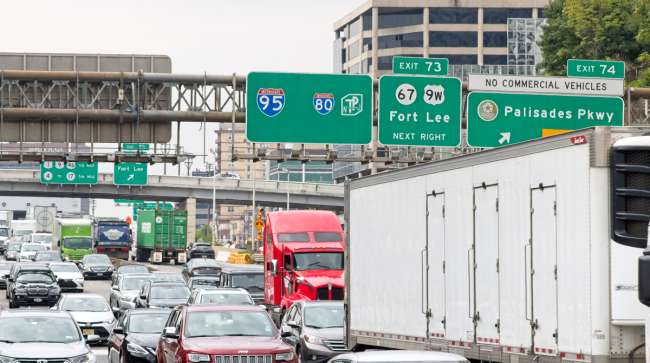Senior Reporter
ATRI: I-95 in Fort Lee, N.J., Still Worst Truck Bottleneck

[Stay on top of transportation news: Get TTNews in your inbox.]
For the seventh year in a row, the intersection of Interstate 95 and state Route 4 near the George Washington Bridge in Fort Lee, N.J., remains the top freight bottleneck in the country, according to a new report by the American Transportation Research Institute.
ATRI’s 2025 Top Truck Bottleneck List measures the level of truck-involved congestion at hundreds of locations on the national highway system. The analysis, based on an extensive database of freight truck GPS data, uses several customized software applications and analysis methods, along with terabytes of data from trucking operations to produce a congestion impact ranking for each location. ATRI’s truck GPS data are also used to support the U.S. Department of Transportation Freight Mobility Initiative.
The bottlenecks detailed in this latest ATRI list represent the top 100 congested locations across more than 325 freight-critical locations ATRI continuously monitors.
The top 10 bottleneck locations were:
- Fort Lee, N.J.: I-95 at SR 4
- Chicago: I-294 at I-290/I-88
- Houston: I-45 at I-69/US 59
- Atlanta: I-285 at I-85 (North)
- Nashville: I-24/I-40 at I-440 (East)
- Atlanta: I-75 at I-285 (North)
- Los Angeles: SR 60 at SR 57
- Cincinnati: I-71 at I-75
- Houston: I-10 at I-45
- Atlanta: I-20 at I-285 (West)

Brewster
“Delays inflicted on truckers by congestion are the equivalent of 436,000 drivers sitting idle for an entire year,” said ATRI President Rebecca Brewster. “These metrics are getting worse, but the good news is that states do not need to accept the status quo. Illinois was once home to the top bottleneck in the country, but following a sustained effort to expand capacity, the Jane Byrne Interchange in Chicago no longer ranks in the top 10.” The data gives policymakers a road map to reduce chokepoints, lower emissions, and drive economic growth, the report said.
Specific to the Jane Byrne Interchange, ATRI noted that the recently completed interchange there helped improve rush hour truck speeds by nearly 25% compared with the pace prior to construction.
(American Transportation Research Institute via YouTube)
Broadly, however, ATRI’s analysis — which utilized data from 2024 — found traffic conditions continue to deteriorate from recent years, in some instances due to work zones resulting from increased infrastructure investment. Average rush hour truck speeds were 34.2 mph, down 3% from the previous year. Among the top 10 locations, average rush hour truck speeds were 29.7 mph.

Spear
“As the Trump administration and new Congress kick off the process of reauthorizing the federal highway bill, this report provides a precise blueprint on where to begin,” said American Trucking Associations President Chris Spear. “These traffic bottlenecks not only choke our supply chains, adding $109 billion annually to the cost of transporting the everyday goods that Americans depend on, but they also impact the quality of life for all motorists who rely on the national highway system to commute to work, school, church, and other life events.”
He added, “Targeted investments to reduce this traffic congestion are exactly the kinds of projects, with a measurable return on investment, that taxpayers come to expect of their elected officials.”
The states with the highest number of top 100 bottlenecks were Texas (12); Georgia (9); California (8); Tennessee (7); and Illinois (6).
ATRI is the nonprofit research arm of ATA.
Want more news? Listen to today's daily briefing below or go here for more info:



